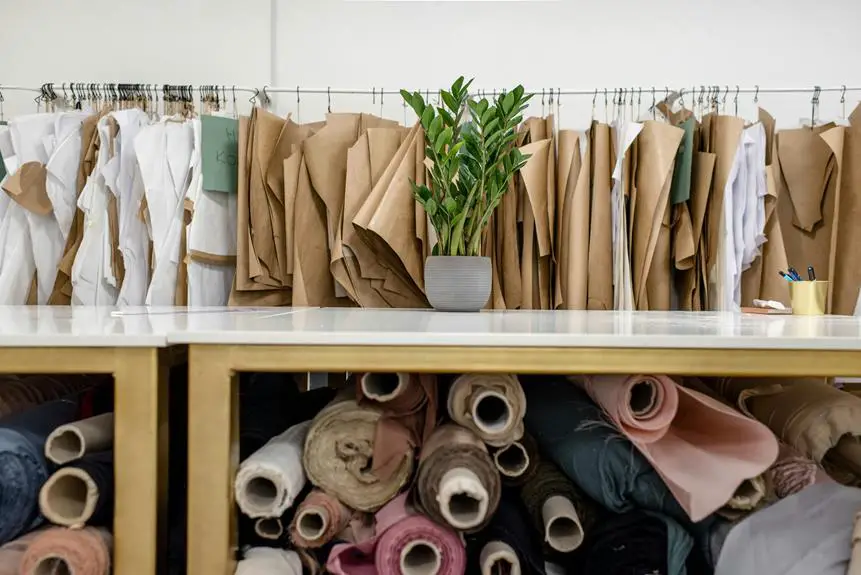When you're choosing the right Oxford fabric for your project, you'll want to start by considering the specific use and environment. Lighter weights might suit casual shirts, while heavier options can be better for bags or outerwear. Then, think about the texture and finish—smooth for formal, coarser for casual. But there's more to it than just these basics. As you narrow down your options, you might find that certain factors can make all the difference in achieving your desired outcome. What other elements should you keep in mind to ensure success?
Table of Contents
Understanding Oxford Fabric Types
When choosing Oxford fabric for your project, it's essential to understand the different types available to ensure you pick the right one for your needs.
Oxford fabric typically comes in three main types: basic, premium, and performance.
Basic Oxford is your go-to option for everyday projects. It's durable and affordable, making it perfect for items like casual shirts or lightweight bags.
Premium Oxford elevates the game with a finer weave and a softer touch. You'll find this type great for dressier shirts or more refined applications.
Performance Oxford is designed for specific uses, often incorporating moisture-wicking or stain-resistant properties. This fabric type is ideal for outdoor gear or athletic wear, as it combines durability with functionality.
Each type has its own unique characteristics, so consider what you're making. If you're after a casual look, basic Oxford works well, but if you need something more sophisticated or technical, premium or performance options are the way to go.
Knowing these distinctions will help you make an informed choice, ensuring your project turns out just as you envision it.
Evaluating Fabric Weights
Understanding the weight of Oxford fabric is key to selecting the right type for your project, as it directly influences the fabric's drape, durability, and overall feel. Weights typically range from light to heavy, each serving different purposes.
When evaluating fabric weights, consider how you'll use the fabric. For instance, lighter weights are great for shirts and linings, while heavier weights work well for bags and outerwear. Here's a quick reference table to help you understand the different weights:
| Fabric Weight | Description | Best Uses |
|---|---|---|
| Light (3-4 oz) | Soft, breathable, and thin | Shirts, summer wear |
| Medium (5-6 oz) | Versatile and durable | Casual wear, light jackets |
| Heavy (7-9 oz) | Thick and sturdy | Bags, outerwear |
| Extra Heavy (10+ oz) | Very durable and coarse | Upholstery, heavy-duty items |
| Specialty (Varies) | Unique textures and finishes | Specialty projects, crafts |
Exploring Different Weaves
Exploring the various weaves of Oxford fabric reveals how texture and structure can significantly impact your project's look and feel. Different weaves offer unique characteristics that can enhance your design, so it's important to choose wisely.
Here's a quick rundown of some common weaves you might consider:
- Plain Weave: This basic weave is durable and offers a smooth finish, making it ideal for casual shirts and lightweight items.
- Basket Weave: Featuring a crisscross pattern, basket weave creates a more textured look. It's great for accessories or when you want to add a bit of visual interest.
- Twill Weave: Known for its diagonal lines, twill weave provides extra durability and a softer drape. It's perfect for pants and jackets that require a bit more structure.
- Satin Weave: This weave has a lustrous finish and a luxurious feel. Use satin-weave Oxford for dressier items where elegance is key.
Considering Finishes and Treatments
Choosing the right finishes and treatments for your Oxford fabric can elevate your project, enhancing both its functionality and aesthetic appeal. When selecting finishes, think about the environment where your fabric will be used. For instance, a water-resistant finish is ideal for outdoor projects, while a softening treatment can make the fabric more comfortable for clothing.
Here's a quick overview of common finishes and their applications:
| Finish Type | Application |
|---|---|
| Water-Resistant | Outdoor gear, bags |
| Stain-Resistant | Tablecloths, aprons |
| Softening Treatment | Clothing, upholstery |
Each finish can significantly impact the durability and look of your fabric. Don't overlook the importance of color treatments either; dyeing can give your fabric a unique flair that suits your project's theme.
Consider how these finishes align with your project's requirements. By carefully evaluating your options, you can choose the perfect treatments that not only meet your needs but also enhance your overall design.
Matching Fabric to Project Needs
When selecting Oxford fabric, it's crucial to consider how its properties align with the specific needs of your project. Different projects require different characteristics from the fabric, so take a moment to assess what your project demands.
Here are four key factors to consider:
- Durability: If your project involves heavy use, opt for a thicker, more robust Oxford fabric that can withstand wear and tear.
- Weight: Lighter fabrics work well for casual shirts or linings, while heavier weights are better suited for bags or outerwear that need structure and support.
- Texture: Think about the feel you want. A smoother texture might be ideal for formal wear, while a coarser finish could add character to casual items.
- Water Resistance: If your project will be exposed to moisture, look for Oxford fabric with a water-resistant treatment to ensure longevity and functionality.
Tips for Buying Oxford Fabric
When you're buying Oxford fabric, think about the weight that best suits your project.
You'll also want to consider the colors and patterns available, as they can significantly impact your design.
Let's explore how these factors can help you make the right choice.
Fabric Weight Considerations
Understanding the fabric weight of Oxford material is crucial for ensuring it meets the needs of your project. The weight of Oxford fabric can significantly impact its durability, drape, and overall appearance.
When selecting the right weight, consider the following tips:
- Purpose: Determine the primary use of the fabric. Lighter weights are ideal for shirts and linings, while heavier weights work better for bags and outerwear.
- Climate: Think about the environment where the finished project will be used. Lightweight fabrics are great for warm climates, while heavier options provide warmth in cooler conditions.
- Stability: Heavier Oxford fabrics tend to have more structure and stability. If you need a fabric that holds its shape, lean towards a heavier option.
- Care Requirements: Consider how easy it's to care for different weights. Heavier fabrics might require more maintenance, while lighter options can be easier to wash and dry.
Color and Pattern Selection
Choosing the right color and pattern for your Oxford fabric can greatly enhance the aesthetic appeal of your project and reflect your personal style. Start by considering the purpose of your project. If you're making a casual shirt, light colors and playful patterns can add a fun touch. For more formal wear, opt for classic colors and subtle designs.
Next, think about the color palette in your wardrobe or home. Choose colors that complement or contrast with existing items. Don't hesitate to test swatches against other fabrics or materials to see how they work together.
When it comes to patterns, you've got plenty of options—stripes, checks, or solids. If you're feeling adventurous, mix and match patterns, but keep in mind that balance is key. Too many competing designs can be overwhelming.
Lastly, consider the season. Bright, vibrant colors are perfect for spring and summer, while deeper tones suit fall and winter. Trust your instincts, and don't shy away from colors that resonate with you. Your choice will ultimately make your project unique and enjoyable.
Frequently Asked Questions
What Is the History of Oxford Fabric Development?
Oxford fabric's history traces back to the early 19th century, originating in England. You'll find it initially used for shirts, evolving over time into a versatile material for various applications, including bags and uniforms.
Can Oxford Fabric Be Recycled or Is It Eco-Friendly?
Yes, oxford fabric can be recycled, but it depends on the specific blend. Many manufacturers are improving eco-friendliness by using sustainable materials, so check for certifications to ensure you're choosing a more environmentally friendly option.
How Does Oxford Fabric Compare to Other Fabrics Like Denim?
When comparing Oxford fabric to denim, you'll notice Oxford's lighter weight and softer texture. While denim offers durability, Oxford's versatility and water resistance make it ideal for various applications, from casual wear to outdoor gear.
What Are Common Uses for Oxford Fabric Beyond Clothing?
You'll find oxford fabric commonly used in bags, backpacks, tablecloths, and outdoor gear. Its durability and versatility make it a popular choice for items requiring strength and style, beyond just clothing applications.
How Should I Care for and Wash Oxford Fabric Items?
To care for your Oxford fabric items, machine wash them in cold water and use a gentle cycle. Avoid bleach, and tumble dry on low heat. Iron on a low setting if needed for wrinkles.
- How Does Ring Spun Cotton Affect Garment Fit and Shape Retention? - August 13, 2024
- What Are the Challenges in Producing Ring Spun Cotton? - August 13, 2024
- Is Ring Spun Cotton Suitable for Plus-Size Clothing? - August 13, 2024







